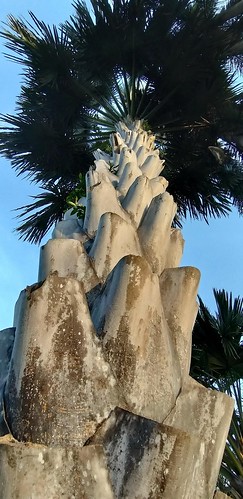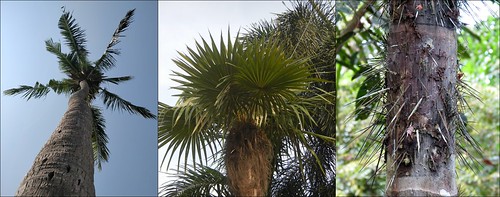Derrick Alcott EARTH'S ORGANISMS
plants trees tropics
Are palm trees really trees?
Recently, I had the good fortune of getting away to some place warm for the weekend. I’m an early riser in a family of not-so-early risers, so the mornings offer a period of peace and quiet to myself. One morning, I found myself sitting under a palm tree that looked a lot like this one (Fig. 1) and I couldn’t help but think: “Palm trees are weird.” I’m a bit of a tree nerd, so I probably spend more time than the average person looking at different trees. This might explain why the features of this palm tree struck me as so bizarre. But if you take a second and look at a palm tree, they really are quite different than most trees.

Fig. 1 A palm tree (Source: Angelo Mariconte via Steemit.com)
It didn’t take long before I turned to Googling some of my curiosities regarding palm trees. I immediately found blog posts stating, “Fun fact: palm trees actually aren’t trees at all!” while other sources claimed palm trees were, in fact, trees. So what’s the verdict? Are palm trees actually trees? This shouldn’t be that hard; for one, it’s in the name! Not to mention, everyone knows what a tree is. To treat this as a more academic affair, all we need to do is look up the definition of a tree from a reliable source and determine if palm trees meet that definition or not. But believe it or not, that’s where we meet our first hang up. There is no universally agreed upon definition of a “tree” [1]!
I found this fact very surprising. It turns out, the distinction between “tree” and “shrub”, for instance, are often debated and fairly subjective. The distinction between a tree and shrub is complicated further by the fact that individuals of the same species may take different forms (from more tree-like to more shrub-like or even viney) depending on the habitat and resources available to the individual. The word “tree” really refers to a set of characteristics that has evolved multiple times throughout the history of plants in different lineages.
Forestry professor and author of multiple tree textbooks, William M. Harlow, has defined a tree as: a woody plant that has a consistent stem above ground year-round that does not wither or die back in autumn, at least 20 ft tall with a single stem/trunk and having a distinct crown shape [2]. In this particular definition, we can see several subjective terms and arbitrary/debatable distinctions (i.e. “distinct crown shape”, “woody plant“, “at least 20 ft tall”) that make it difficult to determine if a palm tree is truly a tree or not.
Some people argue that palm trees are not really trees because they do not display secondary growth – gaining thickness each year – the process responsible for tree rings (Fig. 2). Palms do not display secondary growth because palms are actually more closely related to grasses than any species you would likely think of as a “tree” (maples, oaks, a Christmas pine/fir, etc.). Palm trees also don’t have any branches, which isn’t very tree-like, furthering the argument against their classification as a tree.

Fig. 2 On the left is a cross-section of a yew tree displaying classic tree rings which highlight secondary growth. Each year the tree grows outward from the center one additional ring. (Source: MPF via Wikipedia). On the right is a cross-section of a palm tree. There are no visible rings because palms trees do not gain girth over time. They remain one thickness throughout their life, thus they do not experience secondary growth (Source: Kadeve via Wikipedia).
So what’s the verdict? Can we call palm trees “trees” or should we rename them? Well, if there is any final authority on trees, it might be the International Dendrology Society (dendrology = the study of trees). The International Dendrology Society describes at least one species of palm as a tree on their Trees and Shrubs Online webpage [3]. I’ll let you decide how much weight that ought to carry. In my book, they’re a very unique TREE.
A few more fun facts about palm trees:
Palm tree leaves, called fronds, are long and thin to minimize wind resistance [4].
Palm tree trunks are much more flexible than conifer and deciduous tree trunks [4].
These first two characteristics are very useful in places that experience high winds with regularity, like the hurricane-ridden tropics where palms are found.
Palm trees are evergreen - they never drop their leaves [5].
Coconuts come from palm trees and the double coconut is the single largest fruit in the entire plant kingdom weighing in at 40 pounds or more [5].
Humans living in warmer climates have depended on many different useful characteristics of various palm species to survive for centuries [5].
To this day, palms are one of the most commercially valuable plants, providing fruit (coconuts), cooking oils, soap, cosmetics, wax for polishes, lumber for furniture and boats, and fibers for domestic products like doormats, brooms, hats, and “reed” furniture [5].
The “bark” of palm trees can vary widely from smooth to spiney to shaggy (Fig. 3) [5].
Thanks to global climate change, it might not be too long before palm trees can be found as far north as Canada [6].

Fig. 3 Left: the relatively smooth bark of the coconut tree (Cocos nucifera); Center: the shaggy, fibrous bark of the old man palm (Coccothrinax crinita); Right: the spiney bark of the black palm (Astrocaryum standleyanum). Sources: left = Satish Parganiha, center = judgefloro via Wikipedia, right = Katja Shultz.
References
[1] Gschwantner, Thomas, Klemens Schadauer, Claude Vidal, Adrian Lanz, Erkki Tomppo, Lucio di Cosmo, Nicolas Robert, Daisy Englert Duursma, and Mark Lawrence. “Common tree definitions for national forest inventories in Europe.” (2009).
[2] Harlow, William M. “Trees of the Eastern and Central United States and Canada.” Dover Publications Inc. New York, NY. (1957).
[3] International Dendrology Society. “Trees and Shrubs Online.” http://treesandshrubsonline.org/. Accessed: 2019-10-20.
[4] Wotherspoon, Darla. “Palm Tree Passion.” Accessed: 2019-10-20
[5] Bomhard, Mirriam L. “Palm Trees in the United States.” US Dept of Agriculture Forest Service, Agriculture Bulletin No. 22. (1963).
[6] Reichgelt, Tammo, Christopher K. West, and David R. Greenwood. “The relation between global palm distribution and climate.” Scientific Reports 8, 1 (2018).
More From Thats Life [Science]
- Freshwater Mussels are Declining: Why Should You Care, and What Can You Do?
- The Story of Chestnuts in North America: How a Forest Giant Disappeared from American Forests and Culture
- Friendships, Betrayals, and Reputations in the Animal Kingdom
- Why Don't Apes Have Tails?
- Giant Bacteria, Giant Genomes
- More ›
